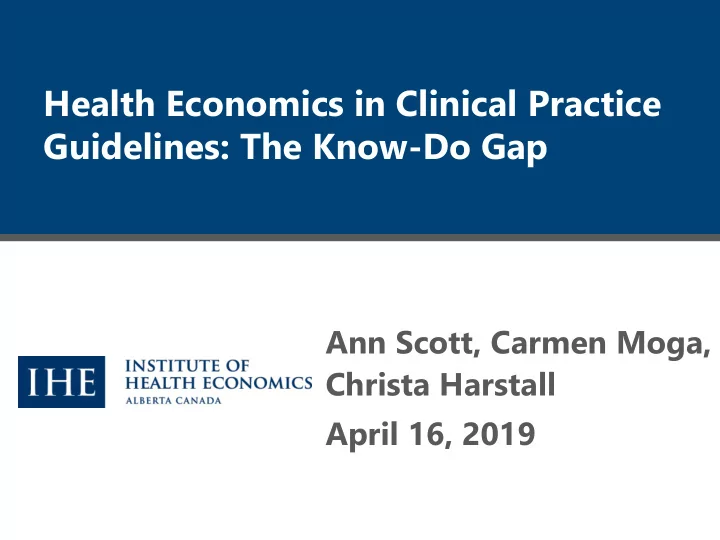

Health Economics in Clinical Practice Guidelines: The Know-Do Gap Ann Scott, Carmen Moga, Christa Harstall April 16, 2019
Disclosure I have no actual or potential conflict of interest in relation to this topic or presentation.
• Started in 2004 as a knowledge The Ambassador translation strategy for promoting Guideline the use of current research evidence Adaptation and to encourage and support best practice in pain management across Development Alberta Program • Program for moving research evidence into practice by: – Increasing clinician knowledge about best evidence – Encouraging clinicians to incorporate research evidence into practice • Evolved into a guideline adaptation program that has since expanded into other areas beyond the original chronic pain remit
Objectives 1. Forecasting economic impact during guideline construction – How to incorporate economic information into the construction of guideline recommendations – How to forecast the potential economic ramifications of guideline recommendations 2. Measuring economic impact after guideline implementation – Create an inventory of methods for evaluating the economic impact of guidelines
Outline of Methods Forecasting economic impact during guideline construction • Theoretical frameworks – o Guidance from internationally recognized standards (IOM, GIN, AGREE) o Literature search Practical methods – o Guideline sample from adaptation process for low back pain o Guideline manuals (CMA, CTFPS, NICE, NHMRC, USPSTF, WHO) o Literature search Measuring economic impact after guideline implementation • Modeling and “real world” studies – o Literature search Studies published in 2005, 2007, 2009, 2011, and 2013 Interventions for prevention, diagnosis, and treatment
Results What we’re supposed to be doing… Forecasting Theoretical Frameworks AGREE II tool (criterion #20) • economic Involve appropriate experts in finding and – analyzing the cost information impact Report economic consequences of implementing – CPG recommendations (if applicable) Describe methods by which the cost information – was sought (e.g. inclusion of health economist in GDG) Identify the types of cost information considered – (e.g. economic evaluations, drug acquisition cost) G-I-N • Include information on cost, if possible – Templates for health economic assessment are – under development IOM • No information available –
Results What we’re supposed to be doing… Forecasting Theoretical Frameworks Peer reviewed literature (n=6) key themes • economic GDG should include a health economist – impact Health economist’s role is to analyze and educate – Discuss economic aspects in parallel not post hoc – Only include resource aspects when necessary – Present analyses in natural units (e.g. days in – hospital) Patient/carer costs only important with respect to – compliance Focus on “barrier” and “balanced” interventions – Not always necessary in “simple” guidelines – Published analyses are of limited use – Keep models simple and transparent –
Results What we are doing… Selected guideline development groups Forecasting Australia (NHMRC), Canada (CMA, CTFPHC), UK • (NICE), USA (USPSTF), international (WHO) main economic impact messages: – Include economists or experts in health economics to advise on search strategies, conduct analyses, and interpret relevant economic data; include a separate decision modelling support team; commission the work if needed – Conduct full economic evaluation (cost- effectiveness, cost-utility, cost-benefit analyses), conduct new modelling studies, or provide contextual information regarding costs – Recommend interventions that increase effectiveness at an acceptable level of increased cost – Describe resource implications and economic consequences of recommended practice – Use a health care payer or societal perspective
Results What we are doing… Peer reviewed literature Forecasting 3 SRs of over 300 CPGs (1985-1998) • economic 14% to 30% considered costs – 1 review of 30 largest US physician • impact specialty societies (CPGs 2008-2012) 57% considered costs, half of which used an – explicit methodology Usually for risk factor reduction or preventive care – 1 SR of over 16 CPGs (2003-2015) • “Cost effectiveness” mentioned 14 times – Increasing trend over time – 1 SR of over 100 most cited CPGs in the • NGC (2014) 43% considered costs and utilized only 6% of the – relevant available cost analyses Factors likely to increase use: quality, – transparency, direct association of costs to patient outcomes
Results What we are doing… Forecasting Seed guidelines from Ambassador Program • economic Sample of 12 CPGs (1 st + 2 nd edition LBP CPG) impact – No economic experts were involved in CPG development – Narrative synthesis of studies on economic evaluation in 9 CPGs – Perspective of analysis was reported in six CPGs: societal, provider, purchaser (n=2), health system (n=4) – Four recommendations on economic aspects were reported in two CPGs
Results Modeling studies (n=45) Measuring Majority conducted by non-stakeholders or • guideline developers/implementers (76%) economic Perspective: 3 rd party payer (64%), provider • impact (13%), societal (9%) Around half (56%) specified a willingness-to-pay • threshold 7% (3 studies) evaluated capacity effects • Type of Analysis Other 2% CEA 20% CEA & Cost Utility 40% Cost Analysis 27% CEA & Cost Analysis 11%
Results Mapping studies (n=38) Measuring Post hoc comparison of guideline practice • Majority conducted by non-stakeholders or economic • guideline developers/implementers (79%) impact Perspective: 3 rd party payer (63%), provider • (24%), societal (8%) 5% specified a willingness-to-pay threshold • 8% (3 studies) evaluated capacity effects • Type of Analysis CEA & Cost Analysis 3% CEA 8% Cost Analysis 89%
Results “Real world” studies (n=43) Majority conducted by non-stakeholders or • guideline developers/implementers (93%) Measuring Perspective: provider (53%), 3 rd party payer • economic (37%) impact 9% (4 studies) evaluated capacity effects • Study Types Other Retrospective 8% Comparison 4% Retrospective Prospective Pre-test/Post-test Comparison 42% 21% Prospective Pre-test/Post-test 25% Type of Analysis Other CEA & Cost Utility 5% 12% CEA CEA & Cost 9% Analysis 2% Cost Analysis 72%
• Use health economic analyses wisely; focus on “problem” Key Messages areas only for Guideline • Get help Developers • Keep it simple • Use a healthcare payer or societal perspective • Don’t forget to consider capacity effects • Steer away from published analyses unless you need modeling inputs • There is no “ideal” method for measuring economic impact
capstone@shaw.ca 1.780.448.4881 www.ihe.ca
Recommend
More recommend